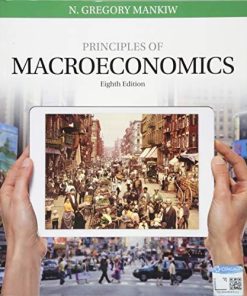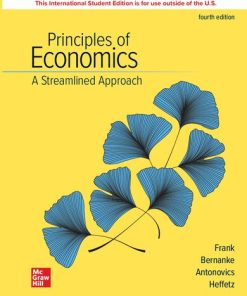(EBook PDF) Principles of Macroeconomics 8th Edition by Robert Frank, Ben Bernanke, Kate Antonovics, Ori Heffetz 1264250444 9781264250448 full chapters
$50.00 Original price was: $50.00.$25.00Current price is: $25.00.
Principles of Macroeconomics 8th Edition by Robert H. Frank, Ben Bernanke, Kate Antonovics, Ori Heffetz – Ebook PDF Instant Download/DeliveryISBN: 1264250444, 9781264250448
Full download Principles of Macroeconomics 8th Edition after payment.

Product details:
ISBN-10 : 1264250444
ISBN-13 : 9781264250448
Author: Robert Frank, Ben Bernanke, Kate Antonovics, Ori Heffetz
Microeconomics Reimagined: Focused Learning, Maximum Impact Embark on a journey into the world of microeconomics with the 2024 release of Principles of Microeconomics. As economic landscapes evolve, this streamlined approach equips faculty to navigate the intricacies of today’s economic challenges for their students. Redefine microeconomic education, where focus equals understanding, and every concept resonates with real-world relevance without overwhelming details. This release is your key to mastering microeconomics in a single semester. Cut through the clutter and emphasize a select set of core principles that form the backbone of this discipline. Our goal extends beyond textbooks. Become a fluent speaker of microeconomic language by actively engaging with real-world examples. From cinema ticket discounts to social norms, our textbook sparks curiosity, fostering meaningful discussions and a deeper understanding of economic principles. Frank, Nobel-Prize winner: Bernanke, Antonovics, and Heffetz bring their expertise to every chapter. Join the movement towards economic enlightenment, where learning is fresh, engaging, and always current.
Principles of Macroeconomics 8th Table of contents:
Chapter 1: Thinking Like an Economist
Chapter 1: Introduction
Economics: Studying Choice in a World of Scarcity
Applying the Cost-Benefit Principle
Economic Surplus
Opportunity Cost
The Role of Economic Models
Four Important Decision Pitfalls
Pitfall 1: Measuring Costs and Benefits as Proportions rather than Absolute Dollar Amounts
Pitfall 2: Ignoring Implicit Costs
Pitfall 3: Taking Sunk Costs into Account
Pitfall 4: Failure to Appreciate the Distinction between Marginal and Average Costs and Benefits
Normative Economics versus Positive Economics
The Invisible Hand
When Individual and Collective Interests Are in Conflict
Economics: Micro and Macro
The Approach of This Text
Economic Naturalism
Summary
Core Principles
Key Terms
Review Questions
Problems
Answers to Self-Tests
Appendix: Working with Equations, Graphs, and Tables
Using a Verbal Description to Construct an Equation
Graphing the Equation of a Straight Line
Deriving the Equation of a Straight Line from Its Graph
Changes in the Vertical Intercept and Slope
Constructing Equations and Graphs from Tables
Solving Simultaneous Equations
Key Terms
Answers to Appendix Self-Tests
Chapter 2: Comparative Advantage
Chapter 2: Introduction
Exchange and Opportunity Cost
The Principle of Comparative Advantage
Sources of Comparative Advantage
Comparative Advantage and Production Possibilities
The Production Possibilities Curve
How Individual Productivity Affects the Slope and Position of the PPC
The Gains from Specialization and Exchange
A Production Possibilities Curve for a Many-Person Economy
Factors That Shift the Economy’s Production Possibilities Curve
Why Have Some Countries Been Slow to Specialize?
Can We Have Too Much Specialization?
Comparative Advantage and Outsourcing
Outsourcing
Summary
Core Principles
Key Terms
Review Questions
Problems
Answers to Self-Tests
Chapter 3: Supply and Demand
Chapter 3: Introduction
What, How, and for Whom? Central Planning versus the Market
Buyers and Sellers in Markets
The Demand Curve
The Supply Curve
Market Equilibrium
Rent Controls Reconsidered
Pizza Price Controls?
Predicting and Explaining Changes in Prices and Quantities
Shifts in Demand
Shifts in the Supply Curve
Four Simple Rules
Efficiency and Equilibrium
Cash on the Table
Smart for One, Dumb for All
Summary
Core Principles
Key Terms
Review Questions
Problems
Answers to Self-Tests
Appendix: The Algebra of Supply and Demand
Answer to Appendix Self-Test
Chapter 4: Macroeconomics: The Bird’s-Eye View of the Economy
Chapter 4: Introduction
The Major Macroeconomic Issues
Economic Growth and Living Standards
Productivity
Recessions and Expansions
Unemployment
Inflation
Economic Interdependence among Nations
Macroeconomic Policy
Types of Macroeconomic Policy
Positive versus Normative Analyses of Macroeconomic Policy
Aggregation
Studying Macroeconomics: A Preview
Summary
Key Terms
Review Questions
Problems
Answers to Self-Tests
Chapter 5: Measuring Economic Activity: GDP and Unemployment
Chapter 5: Introduction
Gross Domestic Product: Measuring the Nation’s Output
Market Value
Final Goods and Services
Produced in a Country during a Given Period
Methods for Measuring GDP
The Expenditure Method for Measuring GDP
GDP and the Incomes of Capital and Labor
Nominal GDP versus Real GDP
Real GDP and Economic Well-Being
Why Real GDP Isn’t the Same as Economic Well-Being
But GDP Is Related to Economic Well-Being
Unemployment and the Unemployment Rate
Measuring Unemployment
The Costs of Unemployment
The Duration of Unemployment
The Unemployment Rate versus “True” Unemployment
Summary
Key Terms
Review Questions
Problems
Answers to Self-Tests
Chapter 6: Measuring the Price Level and Inflation
Chapter 6: Introduction
The Consumer Price Index and Inflation
Inflation
Adjusting for Inflation
Deflating a Nominal Quantity
Indexing to Maintain Buying Power
Does the CPI Measure “True” Inflation?
The Costs of Inflation: Not What You Think
The True Costs of Inflation
Hyperinflation
Inflation and Interest Rates
Inflation and the Real Interest Rate
The Fisher Effect
Summary
Key Terms
Review Questions
Problems
Answers to Self-Tests
Chapter 7: Economic Growth, Productivity, and Living Standards
Chapter 7: Introduction
The Remarkable Rise in Living Standards: The Record
Why “Small” Differences in Growth Rates Matter
Why Nations Become Rich: The Crucial Role of Average Labor Productivity
The Determinants of Average Labor Productivity
Human Capital
Physical Capital
Land and Other Natural Resources
Technology
Entrepreneurship and Management
The Political and Legal Environment
The Costs of Economic Growth
Promoting Economic Growth
Policies to Increase Human Capital
Policies That Promote Saving and Investment
Policies That Support Research and Development
The Legal and Political Framework
The Poorest Countries: A Special Case?
Are There Limits to Growth?
Summary
Key Terms
Review Questions
Problems
Answers to Self-Tests
Chapter 8: The Labor Market: Workers, Wages, and Unemployment
Chapter 8: Introduction
Five Important Labor Market Trends
Trends in Real Wages
Trends in Employment and Unemployment
Supply and Demand in the Labor Market
Wages and the Demand for Labor
Shifts in the Demand for Labor
The Supply of Labor
Shifts in the Supply of Labor
Explaining the Trends in Real Wages and Employment
Large Increases in Real Wages in Industrialized Countries
Real Wage Growth in the United States Has Stagnated since the Early 1970s, while Employment Growth Has Been Rapid
Increasing Wage Inequality: The Effects of Globalization and Technological Change
Unemployment
Types of Unemployment and Their Costs
Impediments to Full Employment
Summary
Key Terms
Review Questions
Problems
Answers to Self-Tests
Chapter 9: Saving and Capital Formation
Chapter 9: Introduction
Saving and Wealth
Stocks and Flows
Capital Gains and Losses
Why Do People Save?
Saving and the Real Interest Rate
Saving, Self-Control, and Demonstration Effects
National Saving and Its Components
The Measurement of National Saving
Private and Public Components of National Saving
Public Saving and the Government Budget
Is Low Household Saving a Problem?
Investment and Capital Formation
Saving, Investment, and Financial Markets
Summary
Key Terms
Review Questions
Problems
Answers to Self-Tests
Chapter 10: Money, Prices, and the Federal Reserve
Chapter 10: Introduction
Money and Its Uses
Measuring Money
Commercial Banks and the Creation of Money
The Money Supply with Both Currency and Deposits
The Federal Reserve System
The History and Structure of the Federal Reserve System
Controlling the Money Supply: Open-Market Operations
The Fed’s Role in Stabilizing Financial Markets: Banking Panics
Money and Prices
Velocity
Money and Inflation in the Long Run
Summary
Key Terms
Review Questions
Problems
Answers to Self-Tests
Chapter 11: Financial Markets and International Capital Flows
Chapter 11: Introduction
The Financial System and the Allocation of Saving to Productive Uses
The Banking System
Bonds and Stocks
Bond Markets, Stock Markets, and the Allocation of Savings
The Informational Role of Bond and Stock Markets
Risk Sharing and Diversification
International Capital Flows
Capital Flows and the Balance of Trade
The Determinants of International Capital Flows
Saving, Investment, and Capital Inflows
The Saving Rate and the Trade Deficit
Summary
Key Terms
Review Questions
Problems
Answers to Self-Tests
Chapter 12: Short-Term Economic Fluctuations: An Introduction
Chapter 12: Introduction
Recessions and Expansions
Some Facts about Short-Term Economic Fluctuations
Output Gaps and Cyclical Unemployment
Potential Output
The Output Gap
The Natural Rate of Unemployment and Cyclical Unemployment
Okun’s Law
Why Do Short-Term Fluctuations Occur? A Preview and a Tale
Alice’s Ice Cream Store: A Tale about Short-Run Fluctuations
Summary
Key Terms
Review Questions
Problems
Answers to Self-Tests
Chapter 13: Spending and Output in the Short Run
Chapter 13: Introduction
The Keynesian Model’s Crucial Assumption: Firms Meet Demand at Preset Prices
Planned Aggregate Expenditure
Planned Spending versus Actual Spending
Consumer Spending and the Economy
Planned Aggregate Expenditure and Output
Short-Run Equilibrium Output
Finding Short-Run Equilibrium Output: Numerical Approach
Finding Short-Run Equilibrium Output: Graphical Approach
Planned Spending and the Output Gap
The Multiplier
Stabilizing Planned Spending: The Role of Fiscal Policy
Government Purchases and Planned Spending
Taxes, Transfers, and Aggregate Spending
Fiscal Policy as a Stabilization Tool: Three Qualifications
Fiscal Policy and the Supply Side
The Problem of Deficits
The Relative Inflexibility of Fiscal Policy
Summary
Key Terms
Review Questions
Problems
Answers to Self-Tests
Appendix A: An Algebraic Solution of the Basic Keynesian Model
Answer to Appendix Self-Test
Appendix B: The Multiplier in the Basic Keynesian Model
Chapter 14: Stabilizing the Economy: The Role of the Fed
Chapter 14: Introduction
The Federal Reserve and Interest Rates: The Traditional Model
The Demand for Money
Macroeconomic Factors That Affect the Demand for Money
The Money Demand Curve
The Supply of Money and Money Market Equilibrium with Limited Reserves
How the Fed Controls the Nominal Interest Rate
The Role of the Federal Funds Rate in Monetary Policy
Can the Fed Control the Real Interest Rate?
The Federal Reserve and Interest Rates: A Closer Look and Post-2008 Developments
How Does the Fed Use Bank Reserves Nowadays to Affect the Money Supply Curve?
Do Interest Rates Always Move Together?
The Effects of Federal Reserve Actions on the Economy
Planned Aggregate Expenditure and the Real Interest Rate
The Fed Fights a Recession
The Fed Fights Inflation
The Fed’s Policy Reaction Function
Monetary Policymaking: Art or Science?
Summary
Key Terms
Review Questions
Problems
Answers to Self-Tests
Appendix: Monetary Policy in the Basic Keynesian Model
Chapter 15: Aggregate Demand, Aggregate Supply, and Inflation
Chapter 15: Introduction
Inflation, Spending, and Output: The Aggregate Demand Curve
Inflation, the Fed, and Why the AD Curve Slopes Downward
Other Reasons for the Downward Slope of the AD Curve
Factors That Shift the Aggregate Demand Curve
Shifts of the AD Curve versus Movements along the AD Curve
Inflation and Aggregate Supply
Inflation Inertia
The Output Gap and Inflation
The Aggregate Demand–Aggregate Supply Diagram
The Self-Correcting Economy
Sources of Inflation
Excessive Aggregate Spending
Inflation Shocks
Shocks to Potential Output
Controlling Inflation
Summary
Key Terms
Review Questions
Problems
Answers to Self-Tests
Appendix: The Algebra of Aggregate Demand and Aggregate Supply
The Aggregate Demand Curve
Shifts of the Aggregate Demand Curve
Short-Run Equilibrium
Long-Run Equilibrium
Answer to Appendix Self-Test
Chapter 16: International Trade and Trade Policy
Chapter 16: Introduction
Comparative Advantage as a Basis for Trade
Production and Consumption Possibilities and the Benefits of Trade
The Two-Worker Production Possibilities Curve
The Many-Worker Production Possibilities Curve
Consumption Possibilities with and without International Trade
A Supply and Demand Perspective on Trade
Winners and Losers from Trade
Protectionist Policies: Tariffs and Quotas
Tariffs
Quotas
The Inefficiency of Protectionism
Summary
Key Terms
Review Questions
Problems
Answers to Self-Tests
Appendix: An Algebraic Approach to Trade Analysis
Problems
Answer to Appendix Self-Test
Chapter 17: Exchange Rates and the Open Economy
Chapter 17: Introduction
Exchange Rates
Nominal Exchange Rates
Flexible versus Fixed Exchange Rates
The Real Exchange Rate
The Determination of the Exchange Rate in the Long Run
A Simple Theory of Exchange Rates: Purchasing Power Parity (PPP)
Shortcomings of the PPP Theory
The Determination of the Exchange Rate in the Short Run
The Foreign Exchange Market: A Supply and Demand Analysis
Changes in the Supply of Dollars
Changes in the Demand for Dollars
Monetary Policy and the Exchange Rate
The Exchange Rate as a Tool of Monetary Policy
Fixed Exchange Rates
How to Fix an Exchange Rate
Speculative Attacks
Monetary Policy and the Fixed Exchange Rate
Should Exchange Rates be Fixed or Flexible?
Summary
Key Terms
Review Questions
Problems
Answers to Self-Tests
People also search for Principles of Macroeconomics 8th:
is principles of macroeconomics hard
brief principles of macroeconomics
10 principles of macroeconomics
economics principles of macroeconomics
principles of macroeconomics pdf
Tags:
Principles,Macroeconomics,Robert Frank,Ben Bernanke,Kate Antonovics,Ori Heffetz
You may also like…
Business & Economics - Professional Finance
Uncategorized
Business & Economics - Economics
Principles of Microeconomics 8th/ISE Edition Robert H. Frank
Business & Economics
Business & Economics - Economics
Principles of Economics, 8e ISE 8th/ISE Edition Robert H. Frank
Biology and other natural sciences - Biology
Business & Economics - Economics
Business & Economics - Economics
Business & Economics - Economics
Principles of Microeconomics: A Streamlined Approach 4th Edition Robert 1264058845 9781264058846












